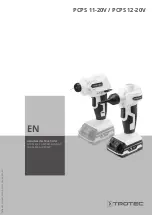
introduction
pressure Switch
- ON/OFF Switch - In
the ON position, the compressor shuts
off automatically when tank pressure
reaches the maximum preset pressure.
In the OFF position, the compressor will
not operate. This switch should be in
the OFF position when connecting or
disconnecting the power cord from the
electrical outlet or when changing air
tools.
regulator
- The regulator controls the
amount of air pressure released at the
hose outlet.
aSMe Safety valve
- This valve
automatically releases air if the tank
pressure exceeds the preset maximum.
exhaust tube
- This tube carries
compressed air from the pump to the
check valve. This tube becomes very hot
during use. To avoid the risk of severe
burns, never touch the exhaust tube.
check valve
- A one-way valve
that allows air to enter the tank, but
prevents air in the tank from flowing
back into the compressor pump.
handle
- Designed to move the
compressor.
air outlet
- A
quick connect coupler
designed to work in combination with
a quick connect plug to quickly and
easily join a pneumatic tool to an air
hose.
pressure Gauges
- These gauges will
show air pressure in the compressor
tank and at the compressor outlet.
outlet pressure Gauge
- Will show
air pressure at the outlet in pounds per
square inch (psi). Make sure this gauge
reads ZERO (by adjusting regulator
knob fully counterclockwise) before
changing air tools or disconnecting air
hose from outlet.
tank pressure Gauge
- Will show air
pressure in tank while the compressor
is running, indicating compressor
is building pressure properly. This
gauge will show maximum pressure
of compressor when it shuts off
automatically at the pressure switch.
Drain valve
- This valve is located
underneath the tank. Use this valve to
drain moisture from the tank daily to
reduce the risk of corrosion.
Drain liquid from
tank daily.
Reduce tank pressure below 10 psi,
then drain moisture from tank daily to
avoid tank corrosion. Drain moisture
from tank by opening the drain valve
located underneath the tank.
installation
location
It is extremely important to install the
compressor in a clean, well ventilated
area where the surrounding air
temperature will not be more than
100°F.
A minimum clearance of 18 inches
between the compressor and a wall is
required because objects could obstruct
air flow.
Do not locate the
compressor air inlet
near steam, paint spray, sandblast areas
or any other source of contamination.
This debris will damage the motor
household use only. Store indoors.
electrical inStallation
1. Check and tighten all bolts, fittings,
etc., before operating compressor.
2. Operate compressor in a ventilated
area so that compressor may be
properly cooled.
3. Compressor should be located
where it can be directly plugged
into an outlet, but if this is not
possible, an extension cord may be
used. It should be selected using the
extension cord chart on page 5 as a
guide.
4. To avoid loss of power and
overheating, it is better to use
additional air hose instead of
extension cords to reach work area.
Figure 3
ASME Safety
Valve
Pressure Switch
Tank Pressure
Gauge
Outlet Pressure Gauge
Regulator
Air Outlet
4
Operating Instructions
www.chpower.com





































